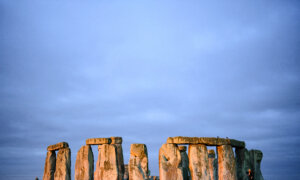The California Department of Fish and Wildlife (CDFW) has published a draft conservation plan aimed at preserving the state’s iconic Joshua trees amid ongoing threats from wildfires and human development.
The 294-page plan calls for avoiding or minimizing both direct and indirect impacts on the Joshua tree and its habitat caused by overgrazing, pesticide use, and unauthorized off-highway vehicle activity.
It also calls for all entities, including governments, businesses, and individuals, to reduce greenhouse gas emissions to help “minimize the impacts of climate change” on the species. It asks that landowners, developers, and land managers minimize the area of Joshua tree habitat that is directly affected by their activities.
The plan also calls on land managers and wildland fire responders to “aggressively fight and contain active wildland fires in or near Western Joshua tree habitats.”
Land managers are also asked to develop measures to minimize impacts when rehabilitating burned areas, according to the plan.
The nonprofit Center for Biological Diversity petitioned in 2019 to list the western Joshua tree as threatened under the state’s Endangered Species Act.
“In many ways, it’s a good comprehensive plan of the things we need to do if the western Joshua tree is going to survive the very, very difficult decades ahead,” the center’s conservation director, Brendan Cummings, said. “Assuming we can keep to a mid-level emissions trajectory, we have a very good chance of saving the species if all the things outlined in this plan are carried out. And primarily that’s doing what we can to protect as many of them as possible.”
The plan was drawn up in response to the Western Joshua Tree Conservation Act, which was signed into law by California Gov. Gavin Newsom in July 2023, as part of efforts to protect the plant and its habitat.
The act required the state to develop a conservation plan in collaboration with governmental agencies, California Native American tribes, and the general public.
It also prohibited the killing or removal of western Joshua trees without a permit and directed the CDFW to submit an annual report assessing the conservation status of the plant to the California Fish and Game Commission.
CDFW officials have set a goal to identify regions where conservation is a top priority by December 2025 and to protect 70 percent of those areas by 2033.
The western Joshua tree, also known as Yucca brevifolia, is an evergreen, tree-like plant that has been “treated as a member of the asparagus family (Asparagaceae),” according to the conservation plan.
It is an important part of California’s desert ecosystem and provides habitat for numerous birds, mammals, insects, reptiles, and other organisms, according to CDFW.
It also carries cultural significance for many tribes. Species distribution models suggest that much of the species’ range may no longer function as viable habitat by the end of the 21st century.
The major threats to the species include human activities, climate change, and wildland fire, the agency says.
“The combined threats to western Joshua tree, coupled with the species’ biology and specific habitat requirements, are causes for substantial concern about the ability of the western Joshua tree population to persist in California long-term,” the agency wrote in its draft plan. “Without some level of direct management, the future of the species will largely depend on its ability to withstand continued habitat loss and to adapt to the hotter and drier conditions that are expected due to climate change.”

Joshua trees burn in the York Fire in the Mojave National Preserve, Calif., on July 30, 2023. (Ty O'Neil/AP Photo)
Due to the ongoing threats facing the species, “thoughtful conservation actions and careful land management are needed to sustain and enhance” the western Joshua tree population in California, the plan states.
The draft plan will need to be approved by the California Fish and Game Commission.
The Associated Press contributed to this report.














